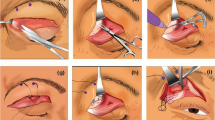Abstract.
The aging process in the human face most often is first visible in the temporal–orbital region, where the ptosis of the eyebrow edge and pseudoexcess of upper eyelid skin are caused by orbicularis oculi muscle downfall. Through the upper blepharoplasty standard incision, the orbicularis oculi muscle is mobilized widely and suspended into a higher position with a stitch put on the deep temporal fascia. In this way the eyebrow is elevated and stabilized, thus reducing so-called ``crow's feet.'' In some cases, when the skin distance between the temporal hairline and the eyebrow edge is too short or when it is necessary to lift the eyebrow edge more than 3 mm, a supplementary temporal incision is recommended to tighten better, in the same direction as the tension vector, the superficial temporal fascia and the overlying skin, firmly bonded to it.
Similar content being viewed by others
Author information
Authors and Affiliations
Rights and permissions
About this article
Cite this article
Leopizzi, G. A Transpalpebral Approach to Treatment of Eyebrow Ptosis. Aesth. Plast. Surg. 23, 125–130 (1999). https://doi.org/10.1007/s002669900254
Issue Date:
DOI: https://doi.org/10.1007/s002669900254




